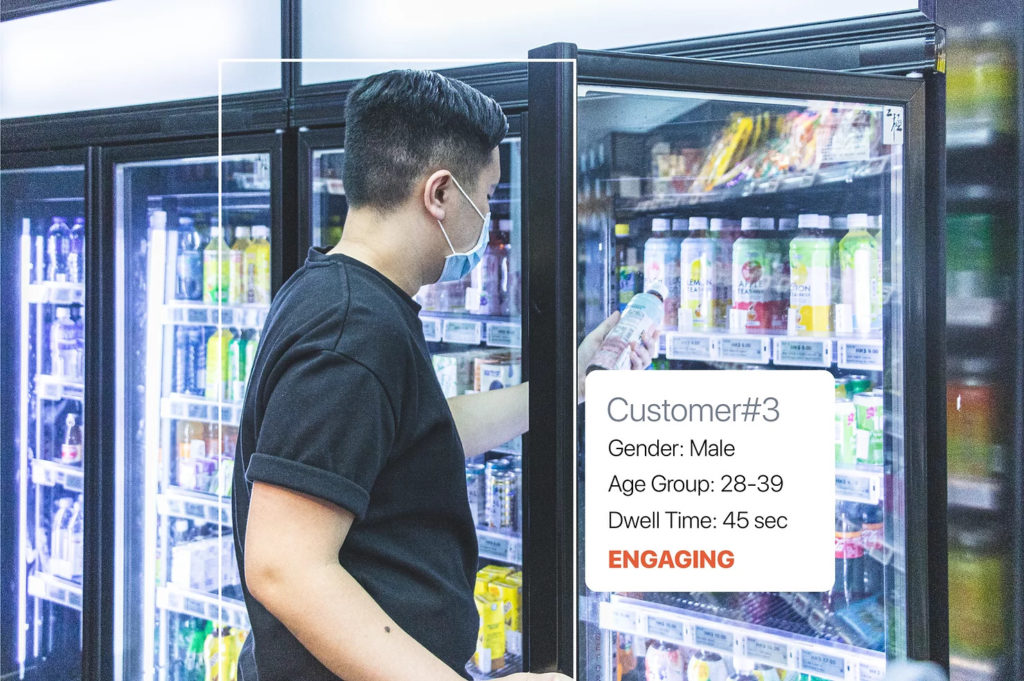[The Chinese version follows the English one. 中文版在底部]
Digitization in marketing: Adopting AI to perform automatic analysis and more sophisticated personalization
Companies always perform market segmentation with manual estimation and assume that the target customers will be attracted by advertisements thereby buying specific products. Traditional market research, which only helps to guess the market trend, takes a long time to finish, and the time costs and the costs of trial-and-error learning are also very high.
Fortunately, with the help of computers and AIs nowadays, marketers can obtain more accurate marketing information. For example, the AI may discover and gather customer and market data in a centralized database via mining, analyze collected data, evaluate and predict target customers’ reactions, or even narrow down different promotional strategies based on consumer characteristics. AI may assist marketers to perform the above tasks, and even automatically design and launch the most suitable marketing campaigns.

What are the most common AI applications? E-commerce is a big trend in many industries, the best part of it is that the browsing and purchasing records of the customers can be gathered and kept by the server, so as to assist brands to react to different customer behavior. Here are some examples:
- AI can help us to perform further market segmentation, so as to perform personalized recommendations
- Take the camping equipment industry as an example, there are two major customer segments: one focuses more on the camping experience and the other one focuses more on the practicality of the camping equipment. Via collecting their browsing and purchasing records, we may know more about the preferences of the customers, precisely recommend suitable products for them, and thereby increase the selling chance.
- AI may help us to decide ways of interacting with different customers. Personalized interaction can make your customers feel like they are taken care of. For example, to customers who seldom open emails, we may only send them emails with important messages and fewer promotional emails should be sent. To those who are more engaging and active, we may then send them more emails with the latest news, and reminders, and even provide them with discounts and coupons via emails. These tailor-made email options might be the key to retaining your customers.
Digitization in retail: In-store equipment and application
Apart from ensuring workplace safety, thermal sensor and computer vision cameras may be a new type of marketing tool. These sensors and cameras may help us to record and analyze customer behavior, so that we may adjust how the products are displayed, as well as decide on better promotional campaigns.

Since the human temperature is usually higher than the room temperature, there will be heat remaining in places where the customers passed by. Like the above heat map, when people stayed in an area for a long time or someone passed by certain areas, the color of those areas in the heat map will be warmer. The thermal sensor may detect the temperature of different locations around the physical store, to help find out the customers’ routes and the most popular aisle. This information may help merchants understand better the physical purchasing habits, as well as evaluate the effectiveness of current product displays. Based on this information, the store manager may arrange better product displays, so as to enhance product exposure and promotion.

As for computer vision cameras (which can be used with the CCTV camera), they may detect facial characteristics (such as gender, age group, and emotions) and gather relevant data about their interactions with the products (such as staying time, what products did they take, observe, or put back, what product did they purchase, and so on.). Via this information, merchants may obtain more accurate conversion rates, so as to predict customer behavior, predict the interactiveness of the products, and figure out the relationship between different types of customers and different types of products. This real-time information may also be sent to staff members so that they can help approach the customers or arrange the staff planning in the physical store.
Digitization in retail: The digitization of physical store
Apart from gathering information for marketing decisions, computer vision may even become a part of the service. One famous example will be Amazon Go. Amazon Go is a supermarket applying sensor fusion with the core of computer vision technology. The customers only need to scan their membership codes while entering the supermarket, and then they can just grab what they want and leave the store. With the detection of the computer vision camera, the system will detect what did the customer take away and automatically check out in their virtual shopping cart. Amazon Go might be the blueprint of the supermarket in the future, which combined offline shops with online shopping carts and provided a better shopping experience to customers.
Freshippo (or Hema Xian Sheng) supermarket by Alibaba also adopted this type of O2O model. Freshippo developed a mobile application for every step of the shopping procedure for customers:
- Via the Freshippo application, customers may scan the physical product for its price, nutrition information, origin, qualification, or even comment from other customers.
- Then, the application will record the browsing history and recommend more suitable, personalized products for the customers.
- Also, customers may use facial recognition to pay via the application.
- The application can even be an online supermarket, customers may place orders on the phone, and the staff members in the physical store will pack the products for the customers, and deliver them to the customers within 3km in 30 minutes.
Digitization in marketing: Inventory management with big data
More and more brands and factories are starting to make use of big data for their production and inventory management. Companies may combine data gathered from physical and online stores, and have a macro view of the sales performance (market-base or district-base), search history, and browsing history. These data may help the brands to:
- Plan: Analyze and predict the demand for different products, and plan the number of upcoming orders or production
- Inventory management: decide the suitable stock level in the warehouse and the stores, and avoid stacking too much inventory.
- Better logistic reaction: by planning inventory distribution in advance, logistics may react quickly and ensure the supply of products.
- Product display: better planning on the product display in the physical stores based on the changes of customers’ preferences, so as to enhance the attractiveness of physical store.
Apart from internal use, stock information may also be shared with customers so that they will know where to find specific products. More transparent inventory information may help increase sales since the customers may look for products without too much trouble (especially when some products need to be ordered in advance.)

Thank you for reading! The above are the four digital trend of the retail and marketing industry that we think is worth sharing with you! If you would like to learn more about how technology is shaping the world of business, feel free to click here and visit our website. If you are considering digitizing your business or even developing your own application, feel free to contact us too!
零售和市場行銷行業的數碼化
Digitization in marketing: 利用 AI 自動化分析,精確地進行個人化行銷
過往品牌想要進行市場區隔 (Market segmentation),大多要靠推測,估計區隔內的目標顧客會被廣告吸引/購買個別產品。而且需要較長時間才能收集到完整的數據去評估市場反應, 所花費的時間成本和試錯成本都比現在大多了。
現時,在電腦和 AI 的幫助下,不論是探勘 (Mining) 顧客或市場數據到中央資料庫、觀察及分析數據用作評估和預測目標觀眾反應,還是就不同消費者特徵再細分出不同的後續推廣策略⋯⋯ Marketers 都可以輕鬆用電腦做到,更甚者,不用人手操作,AI 系統已自動化完成數據探勘、分析和自動執行設定好的後續方案。

較常見的 AI 應用又有哪些呢?線上銷售是大勢所趨,其好處是顧客的瀏覽和購買記錄都能被伺服器收集,幫助品牌對各種不同的顧客行為作出反應。例子有:
- AI 可以幫助我們進一步細分市場,進行個人化商品推薦
例如即使單單在露營用品市場內,其實還有兩種顧客群體:一種較注重舒適的露營體驗;另一種則較注重露營用品的實用性。透過收集他們過往的瀏覽和購買記錄,我們便能得知顧客的偏好,精準向他們推薦合心意的露營裝備,才能增加成功推銷的機會。 - AI 可以幫助我們決定與不同顧客的互動方式,個人化的互動能讓品牌看似更「貼心」
例如面對不常開啟郵件的顧客,降低發送電子報的頻率,只傳送重要訊息;面對有興趣知道更多、互動率較高的顧客,則可以更常更新品牌的最新消息予他們等。又例如電郵提醒顧客他們擱置在購物車內的商品、向長時間未消費的顧客提供回歸優惠券、向生日顧客提供生日優惠等,這些貼心的互動都有可能成為留住顧客的關鍵。
Digitization in retail: 安裝在實體店內的工具
温度感應器和電腦視覺鏡頭除了能用作保障工作環境安全 (閱讀更多:如偵測工作場所危機、建築物火災等) 外,把它們安裝在零售店鋪裡,便能變成新型的產品行銷工具。我們可以使用這兩種感應器去紀錄和分析顧客的行為,從而透過調整上架產品或調動上架擺位來達到有效的營銷/推廣效果。

由於人體體温會高於室內環境温度,加上在人走過及停留過的地方會有留有餘温。正如上圖 Heat Map 中可見,愈多人走過/停留較長的地方會呈現愈暖的色調。安裝温度傳感器偵測店內不同位置的温度,可以幫助啇家找到較多顧客選擇的購物動線、常停留的貨架等資訊。這些資訊可以幫助商戶了解顧客的實體消費習慣、評估店鋪現有陳列佈局的成效、為日後上架和調整商品位置時提供參考,透過調整位置提高商品的互動率/推廣個別商品。

而電腦視覺系統 (可直接配搭CCTV鏡頭使用) 則可以用作辨別進店顧客的表面特徵 (例如性別、年齡層、表情),以及收集他們與產品互動的數據 (如逗留時間、拿取及放回貨品之數據、有否消費等資訊)。透過這些資訊記錄,商戶可以更準確得知商品的轉換率 (Coversion rate)、預測顧客在進店後的行為、預期的商品互動、收集不同顧客特性與商品互動率之間的關係等。也可以將數據實時傳送予店員,以便他們與顧客進行接觸及互動/ 調整店內人手安排 。
Digitization in retail: 實體零售店、超市的數碼化策略
電腦視覺系統除了能用作協助商戶作出行銷決策外,它還能直接成為服務的一部份。最著名的例子是國外的亞馬遜超市 Amazon Go,超市內應用了以電腦視覺為核心的感測器整合技術 (Sensor Fusion),顧客只需要在進入超市時掃描會員憑證,便能直接在超市內拿起商品直接離開,拿取了的商品會自動在虛擬購物車內結帳。Amazon Go 可以說是未來超市的營運範本,融合線下實體商舖與線上購物車,為消費者創造更快捷方便的超市購物體驗。
阿里巴巴的盒馬鮮生超市 (Freshippo/ Hema XianSheng) 也在應用線下融合線上的模式。盒馬以一個手機應用程式包辦了消費者的整個超市購物流程:
- 透過盒馬超市的手機應用程式,顧客可以掃描商品前的條碼查看其即時價格、營養資料、產地、合格證甚至是其他顧客對該商品的評價;
- 其次,程式會記錄顧客過往的瀏覽和購買記錄,為顧客提供更多個人化商品推薦;
- 再者,消費者在結帳時能透過應用程式使用「掃臉支付」;
- 不只,程式還可以是一間線上超市,門店採用前店後倉,顧客下單後即時由超市揀貨員為訂單揀貨, 30 分鐘內送到 3 公里內的指定地址。
Digitization in marketing: 運用大數據進行倉存管理
越來越多品牌和工廠開始運用大數據於生產和倉儲管理系統。品牌能整合門店和網上商店收集到的數據,宏觀查看不同商品按時間 (如按季/按月) 或按地理位置 (如按市場/按地區) 的銷情、搜索和瀏覽記錄,而這些數據可以幫助品牌:
- 規劃:分析和預測不同商品的需求量,決定未來一季的入貨/生產量
- 庫存管理:部署門店和倉庫需要的存貨量,避免積壓太多庫存
- 系統物流反應:做到提前/即時調動和分配庫存,快速響應市場需求及確保商品供應
- 店舖陳設:根據顧客購買喜好的轉變,轉換門店商品陳列,提升門店吸引力
庫存數據除了能在企業內部分享及檢視外,品牌更可以選擇向顧客分享不同分店個別商品的庫存量,方便想要購買現貨的消費者。更具透明化的分店庫存資料可以提升銷售額,因為顧客在購物時可能遇到的阻力會大大減少(如遇到需要訂貨/調貨的情況)。

感謝你的閱讀!以上我們為你整理了四個零售和市場行銷行業的數碼化方向,如果你想查閱更多關於科技和 CRM 市場趨勢的文章,歡迎 接此 前往我們的網站。如果你正在考慮數碼化你的品牌/欲開發品牌應用程式,歡迎隨時聯絡我們查詢。